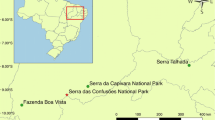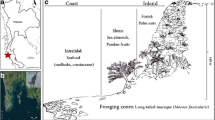Abstract
Stone-play, a newly innovated cultural behavior, has been observed among the free-ranging Arashiyama B troop Japanese macaques near Kyoto, Japan since 1979. Conditions in which the non-purposeful handling of stones might possibly give rise to tool behavior are discussed. The progression of this behavior is traced through three phases: transmission, tradition, and transformation. During the first two phases, through social learning, the behavior was established within the group as a regular item of their behavioral repertoire and was most frequently observed after eating provisioned grain. In the third phase, observations suggest a “faddish” shift in the practice of certain behavioral sub-types between 1984 and 1985. During this period young individuals increasingly began to carry stones away from the feeding station, mixing stone manipulation with forage-feeding activities in the forest. Observations suggest under such conditions, stone handling is likely to lead to the occasional use of stone as a tool. This conclusion probably can be applied to species other thanMacaca fuscata. Consideration of the eco-setting and social learning correlates of stone handling suggests how the instrumental use of stone might emerge from a tradition of non-instrumental manipulation.
Similar content being viewed by others
References
Bard, K. L. &J. Vauclair, 1984. The communicative context of object manipulation in ape and human adult-infant pairs.J. Human Evol., 13: 181–190.
Beck, B. B., 1980.Animal Tool Behavior: The Use and Manufacture of Tools by Animals. Garland, New York.
Camberfort, V. P., 1981. A comparative study of culturally transmitted patterns of feeding habits in the chacma baboonPapio ursinus and the vervet monkeyCercopithecus aethiops.Folia Primatol., 36: 243–263.
Candland, D. K., J. A. French, &C. N. Johnson, 1978. Object-play: test of a categorized model by the genesis of object play inMacaca fuscata. In:Social Play in Primates,E. O. Smith (ed.), Academic Press, New York, pp. 259–296.
Goodall, J., 1968. The behaviour of free-living chimpanzees in the Gombe Stream Reserve.Anim. Behav. Monogr., 1: 161–311.
Hamilton, W., 1973.Life's Color Code. McGraw-Hill, New York.
————,R. Buskirk, &W. Buskirk, 1978. Environmental developmental determinants of object manipulation by chacma baboons (Papio ursinus) in two Southern African environments.J. Human Evol., 7: 205–216.
Hiraiwa, M., 1975. Pebble-collecting behavior by juvenile Japanese monkeys.Monkey, 19(5–6): 24–25. (in Japanese)
Huffman, M. A., 1984. Stone-play ofMacaca fuscata in Arashiyama B troop: transmission of a non-adaptive behavior.J. Human Evol., 13: 725–735.
Isaac, G., 1971. The diet of early man: aspects of archaeological evidence from Lower and Middle Pleistocene sites in Africa.World Archaeol., 2: 278–299.
————, 1983. Aspects of human evolution. In:Evolution from Molecules to Man,D. S. Bendall (ed.), Cambridge Univ. Press, Cambridge, pp. 509–543.
Itani, J., 1958. On the acquisition and propagation of a new food habit in the troop of Japanese monkeys at Takasakiyama.Primates, 1: 84–98. (in Japanese). Translated into English for Japanese Monkeys, a Collection of Translations Selected byKinji Imanishi, S. A. Altmann (ed. & publ.).
Kawai, M., 1965. Newly acquired pre-cultural behavior of the natural troop of Japanese monkeys on Koshima islet.Primates, 6: 1–30.
Kawamura, S., 1959. The process of sub-human culture propagation among Japanese macaques.Primates, 2: 43–60.
Kurland, J. A. &S. J. Beckerman, 1985. Optimal foraging and hominid evolution: labor and reciprocity.Amer. Anthropol., 87: 73–93.
Lancaster, J. B. &C. S. Lancaster, 1983. Parental investment: the hominid adaptation. In:How Humans Adapt, a Biocultural Odyssey,D. J. Ortner (ed.), Smithsonian Institution Press, Washington, D.C., pp. 33–56.
McGrew, W. C., 1977. Socialization and object manipulation of wild chimpanzees. In:Primate Biosocial Development,S. Chevalier-Skolnikoff &F. E. Poirier (eds.), Garland, New York, pp. 261–288.
Menzel, Jr. E. W., K. R. Davenport, &C. M. Rogers, 1970. The development of tool using in wild-born and restriction-reared chimpanzees.Folia Primatol., 12: 273–283.
Nishida, T., 1986. Learning and cultural transmission in non-human primates. In:Primate Societies,D. Cheney,L. Leland,L. Seyfarth,B. B. Smuts,T. Strhusaker, &R. W. Wrangham (eds.), Univ. of Chicago Press, Chicago. (in press)
Parker, S. &K. Gibson, 1977. Object manipulation, tool use and sensorimotor intelligence as feeding adaptations inCebus monkeys and great apes.J. Human Evol., 6: 623–641.
Rumbaugh, D., 1970. Learning skills of anthropoids. In:Primate Behavior, Vol. 1,L. Rosenblum (ed.), Aldine, New York, pp. 1–70.
Schiller, P. H., 1957. Innate motor action as a basis of learning. In:Instinctive Behavior,C. H. Schiller (ed.), International Univ. Press, New York, pp. 264–287.
Author information
Authors and Affiliations
About this article
Cite this article
Huffman, M.A., Quiatt, D. Stone handling by Japanese macaques (Macaca fuscata): Implications for tool use of stone. Primates 27, 413–423 (1986). https://doi.org/10.1007/BF02381887
Received:
Accepted:
Issue Date:
DOI: https://doi.org/10.1007/BF02381887




